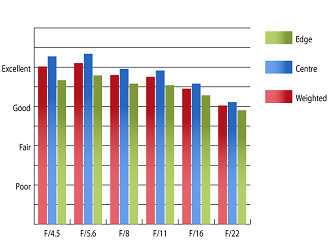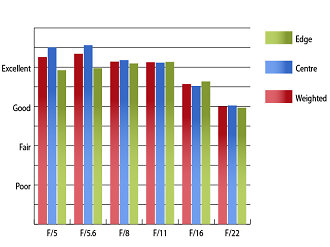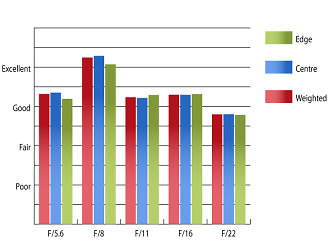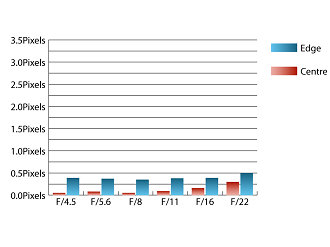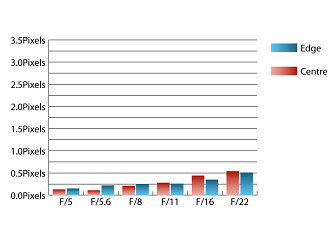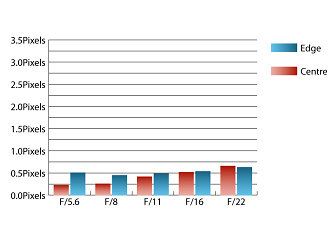Canon EF 100-400mm f/4.5-5.6L IS II USM Lens Review
Canon EF 100-400mm f/4.5-5.6L IS II USM Performance
At 100mm, sharpness is already excellent in the centre of the frame at maximum aperture. Peak performance across the frame is achieved at f/5.6. Here sharpness in the centre is excellent and very good towards the edges of the frame.
At 200mm, sharpness increases to outstanding levels in the centre at maximum aperture, with peak performance across the frame being realised at f/5.6 again with outstanding sharpness in the centre and performance that falls just short of excellent towards the edges of the frame.
Finally, at 400mm the lens still performs well, with good sharpness across the frame at maximum aperture. Peak sharpness is achieved at f/8 where sharpness is excellent across the frame.
How to read our charts
The blue column represents readings from the centre of the picture frame at the various apertures and the green is from the edges. Averaging them out gives the red weighted column.The scale on the left side is an indication of actual image resolution. The taller the column, the better the lens performance. Simple.
For this review, the lens was tested on a Canon EOS 5D Mark III using Imatest.
Chromatic aberrations are extremely well controlled for a telephoto zoom lens, just exceeding half a pixel width at 400mm. This low level should cause virtually no issues, even in large prints and harsh crops from the edges of the frame.
How to read our charts
Chromatic aberration is the lens' inability to focus on the sensor or film all colours of visible light at the same point. Severe chromatic aberration gives a noticeable fringing or a halo effect around sharp edges within the picture. It can be cured in software.Apochromatic lenses have special lens elements (aspheric, extra-low dispersion etc) to minimize the problem, hence they usually cost more.
For this review, the lens was tested on a Canon EOS 5D Mark III using Imatest.
Falloff of illumination towards the corners of the frame is well controlled with the corners only being 0.92 stops darker than the image centre at 100mm and 1.6 stops darker than the centre at 400mm. Visually uniform illumination is achieved with the aperture stopped down by one full stop from maximum aperture throughout the zoom range.
Distortion is very well controlled for a 4x zoom lens. At 100mm 0.94% barrel distortion is present, which is replaced by 0.94% pincushion distortion at 400mm. The distortion pattern is uniform across the frame which should ensure that applying corrections in image editing software afterwards is straightforward.
Even without the supplied hood, resistance to flare is high and contrast is excellent, even when shooting into the light.
Value For Money
Being priced at around £2000, this lens costs a fair amount more than its predecessor ever did, which will have an impact on the perceived value for money this lens provides. This is especially true as the older version of this lens is still available to buy new from some retailers, priced at around £1070, which is a significant saving.
If you're shopping for a lens covering this range, Sigma's 120-400mm f/4.5-5.6 DG OS may also be on your list of considerations being priced significantly lower at around £650. This lens does sport silent focusing but lacks weather sealing.
Add your message
Please login here or if you've not registered, you can register here. Registering is safe, quick and free.
photodo Stats
428 MTF tests
74 in-depth photodo reviews
100+ users join each day
Help the lens community by reviewing or rating a lens today via our lens search
Latest Lens Reviews
- Chinon 28mm f/2.8 Vintage Lens Review
- Canon EF 70-200mm f/4L IS II USM Lens Review
- Samyang AF 85mm f/1.4 EF Review
- Sigma 70mm f/2.8 DG Macro Art Review
- Samyang AF 24mm f/2.8 FE Review
- Meike 50mm f/1.7 Review
- Tamron 70-210mm f/4 Di VC USD Review
- Lensbaby Burnside 35mm f/2.8 Review
- Asahi Super Takumar 50mm f/1.4 Review
- Asahi Super-Multi-Coated Takumar 135mm f/3.5 Review
